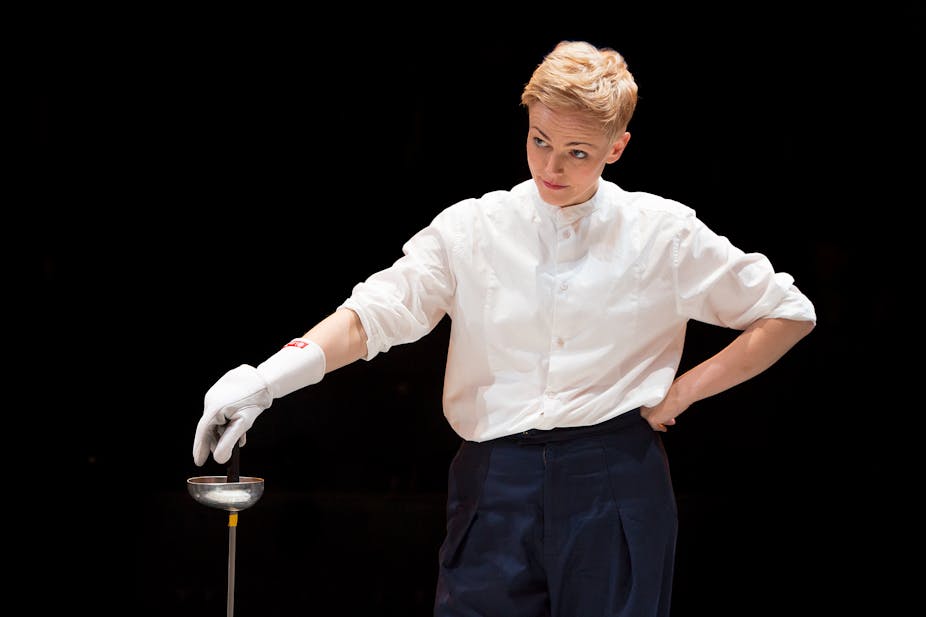The ghost, in this autumn’s Royal Exchange Theatre production of Hamlet, is in the light bulbs. Hung over the stage, they flicker and hum as they mark Old Hamlet’s movements. They also set the scene for the production: this is an indoors, domestic Hamlet, with Fortinbras and the wars cut out to focus on family politics.
The quaintly incandescent light bulbs, together with the toned-down modern dress referencing fashion from the 1920s to the 1990s position this Hamlet firmly in the 20th century. This works well: there is a haunting sense of the recent past; not now, but now-ish; uncomfortably close, but with a sense of distance. A credit card is flashed once but this is as modern as it gets. It’s no digital Hamlet, but it bears a 20th-century burden in a number of interesting ways.
First is the ghost, or the ghosts: John Shrapnel plays both of the father figures, Old Hamlet and Claudius. Old Hamlet, not in armour but in the white nightie that is popular in many modern King Lear productions, evokes the old people’s home rather than the wars. Here is a desperate old man, angry, fragile and yet commanding. Meanwhile, Claudius is the authoritative, suave, quietly menacing politician.

This double-casting inevitably merges two fathers into one, more abstract, father figure and so alludes to influential 20th-century psychoanalytic readings of Hamlet. Sigmund Freud’s Oedipus complex, together with Jacques Lacan’s re-reading of it, rendered Hamlet emblematic of modern man trapped by the struggles of identification and rejection with symbolic fathers and an oppressive patriarchal culture.
With or without this 20th-century legacy, Hamlet is a play about fathers – and about dangerous family relationships in a fraught patriarchal culture. In this Hamlet production with a female lead – played by Maxine Peake – it seems that, as Lacan suggests: “The phallus is a ghost”. But a ghostly patriarchy still has effects.
It has become a commonplace in gender studies that cross-dressing on stage exposes the artificiality of gender roles in life; and the first thing that stands out about Peake’s Hamlet is that he labours neither the butch nor the femme. And yet, when this Hamlet embraces the many opportunities for lewd physical jokes the play offers, it renders the phallus, in its toilet roll incarnations, wonderfully ridiculous.

There is a long history of female characters playing Hamlet, and as literary critic Tony Howard points out in Women as Hamlet, they often did so within politically radical contexts, like the abolitionist Fanny Kemble in the mid-19th century. This production makes no grand statements, but its laconic gender play is nonetheless effective.
As is well known, women on the early modern stage were played by young male actors; Shakespeare and other playwrights of his time often exploited the potential for meta-theatrical jokes this brings. In Ben Jonson’s Epicene, the central female character is a woman who turns out to be a man in disguise – played, of course, by a man.
In this production, instances of gender-switching tend to point not to the theatre but to a changing everyday reality. Polonius, the other important father in the play, becomes Gilian Bevan’s brilliant Polonia. In a miserable skirt suit, ridiculous power-dressing heels and smug speeches she evokes all too well the contemporary hate-figure of the middle-aged female politician. Alas, poor Polonia never quite fits the protocols of masculine power well enough. There is a real question here of how to play at public power as a woman.
Elsewhere, there are signs that some cultural scripts are changing more easily: Claire Benedict turns Marcellus into the convincing modern soldier Marcella. She also plays an unapologetically maternal player king opposite a wildly camp Ben Stott as player queen. After decades of queer media culture, this role-switching seems remarkably unremarkable. In fact, the queerest moment is perhaps the play-within-the play, when child actors in the dumb show render the adult murder story into a comical playground battle for affections.

The production’s subtle gender games are perhaps best exemplified in the graveyard scene; here, Michelle Butterly excels as first gravedigger of insignificant gender but significant manual labour. The gravedigger’s complaint about Ophelia’s special treatment in her burial, while funny, is also especially poignant here, where a worker in a high-visibility vest shovels apocalyptic piles of old clothes rather than bones. Whether this represents the detritus of a consumer society or an evocation of the mass graves and genocide of the 20th century, in this moment the play is no longer about the modern family tragedy, but about who or what determines who lands on the rubbish heap, and about who clears the rubbish away.
In a production that doesn’t make as much as it might have done of the grotesque potential of an early modern revenge play, here there is a glimpse of the baroque: the clothes, in fragments, evoke the dead bodies missing from them; the clothes themselves are the remainders of the many roles played in a lifetime, feminine, masculine and else. When Ophelia’s white dress is placed among the dirty rags to mark her burial, it seems rather too much in its unambiguous, impossible femininity.
Hamlet is at the Royal Exchange Theatre until October 25 2014.

